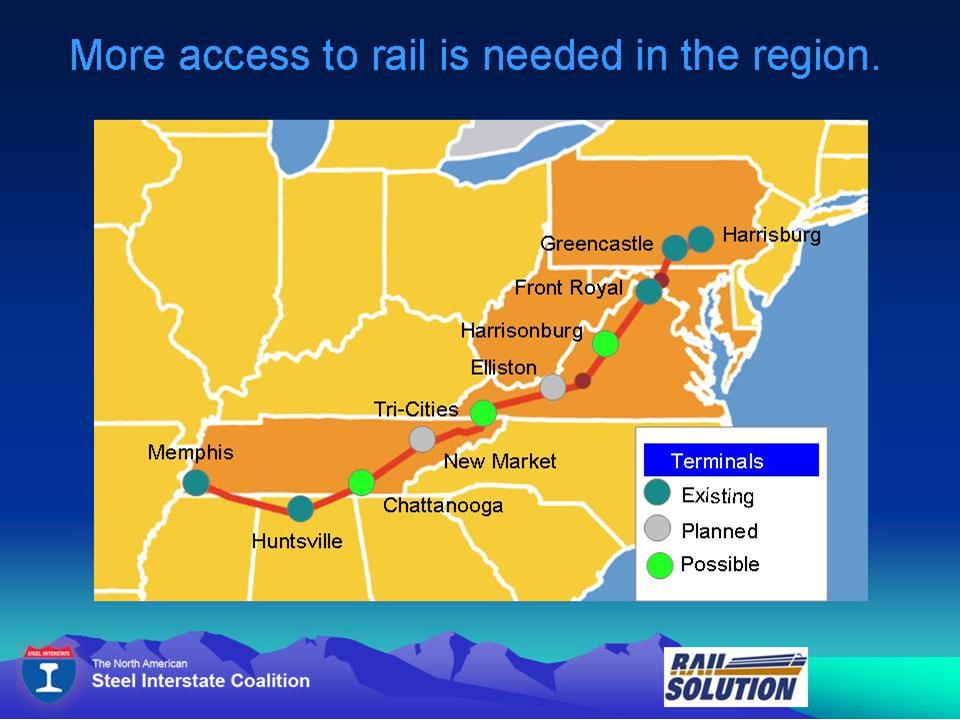Inland ports needed to increase the use of rail in the Norfolk Southern Crescent Corridor Valley Route in TN and VA
Nationally, more inland ports (terminals) are needed to extend the use of rail, reduce the number of trucks on the highways, and reduce transportation costs and environmental impacts. Georgia officials and CSX see this need and are doing something about it. The Knoxville News-Sentinel recently published an article about the new inland Appalachian Regional Port to be constructed in Chatsworth, Georgia.
Inland port in north Georgia to be developed
The port, to be located just off I-75, in north Georgia will be used to transport goods produced in East Tennessee, north Georgia, Alabama and parts of Kentucky to the deepwater port of Savannah, Georgia, a distance of about 330 miles. It is estimated that 40,000 tractor-trailer loads annually of vehicles, auto parts and other manufactured goods will be put on CSX rail cars for the journey to Savannah. The inland port will be serving a growing vehicle parts and assembly industry in the region.
The News-Sentinel article said that Georgia Gov. Nathan Deal, the Georgia Ports Authority, Murray County (Ga.) officials, and Jacksonville, Fla.-based CSX Transportation have signed a memorandum of agreement establishing the Appalachian Regional Port, on a 42-acre site that will offer quick access to U.S. 411 and I-75, and be convenient to two other major highways — nearby I-24 and I-59. It will also connect to CSX mainlines that feed in from Nashville, Knoxville and Chattanooga.
State government officials are looking for ways to reduce demands on the highways
The idea of inland ports is certainly not new or original. What is new is revived interest and action by state and local officials, along with railroads, to undertake initiatives to decrease transportation costs and impacts through smart use of rail. Thus, we have the agreement of Georgia and CSX officials.
More detailed analysis needs to be done in other parts of the county to see if similar inland ports are economically feasible to provide regional transportation solutions. Furthermore, public-private partnerships that benefit regions of the country ought to be receiving a lot of attention. There are funds for investment in these types of facilities and systems, but the leaders of the various parts of the transportation and government infrastructure must step up to take advantage.
Need for analysis of Norfolk Southern Valley Route of the Crescent Corridor
That brings us to the region of great interest to Rail Solution members. There is no better example of an underdeveloped intermodal freight corridor than the Valley Route of the Crescent Corridor in the Norfolk Southern system. No intermodal terminals exist to serve the region served by I-81 in Virginia and Tennessee and I-40 and I-75 in Tennessee. The Norfolk Southern basically operates a railroad bridge over most of the Valley region, and there is little interchange of intermodal traffic between highway and rail. See this map of the Norfolk Southern depicting their intermodal network, which shows no terminals between north Alabama and northern Virginia. (To see the intermodal terminals, click “intermodal” at the top of the map bar.)
Intermediate terminals should be developed on the Norfolk Southern Valley Route of the Crescent Corridor
Intermediate terminals (or inland ports) on the Norfolk Southern Valley Route of the Crescent Corridor would enable intermodal traffic to and from the Valley region, most of which is now served by trucks. See map for location of Valley Route and terminals (inland ports) that are either existing, planned, or possible. The ones listed as possible are for rail intermodal corridor technology for a high volume intermodal corridor with quick on-loading and off-loading of trucks and/or containers.
As noted on the map, terminals are slated for development in the region, but these have been on hold—the planned Norfolk Southern terminal at New Market, Tennessee north of Knoxville near I-81 and I-40 and another Norfolk Southern terminal near Roanoke at Elliston, Virginia near I-81.
Inland Port at Elliston, Virginia
There would appear to be good reasons for greater interest in the inland port at Elliston. The Elliston terminal could be used to transfer intermodal shipments to and from western Virginia, western North Carolina, and southern West Virginia and from the Heartland Corridor. The development of the Elliston terminal would be beneficial to the port of Norfolk, and to the need for improvement of the transportation of goods on the US 460 highway and parallel Norfolk Southern Heartland route. Virginia has been planning to outlay huge sums to improve US 460, but perhaps that need could be reduced by making rail more convenient and accessible. Terminals developed at closer intervals with quick loading and unloading technology for containers could expand rail use even further.
Inland Port at New Market, Tennessee
The Inland Port at New Market, Tennessee, now apparently on hold, would serve east Tennessee, western North Carolina, eastern Kentucky, and part of southwest Virginia, providing intermodal transfer service for the entire region. Trucks serving the region could be operated round trip within an 8 hour period from the New Market Inland Port. The development of this port would relieve traffic congestion on parts of I-40, I-75, and I-81.
Need for Analysis of Benefit of Intermediate Inland Ports
With some urgency, Virginia and Tennessee officials, along with the Norfolk Southern, should evaluate the feasibility of speeding up the planned terminals at New Market and Elliston to relieve their highways and to provide economic development. In addition, it would be a good time to consider with Norfolk Southern possible advantages of additional inland ports near Chattanooga, Tennessee and Harrisonburg, Virginia. The feasibility study should include assessment of cost and benefits, environmental impacts, and financing alternatives for additional inland ports (terminals) and any infrastructure improvements needed for the highway and railroad system.
Follow Us
Share This

Leave a Reply
You must be logged in to post a comment.